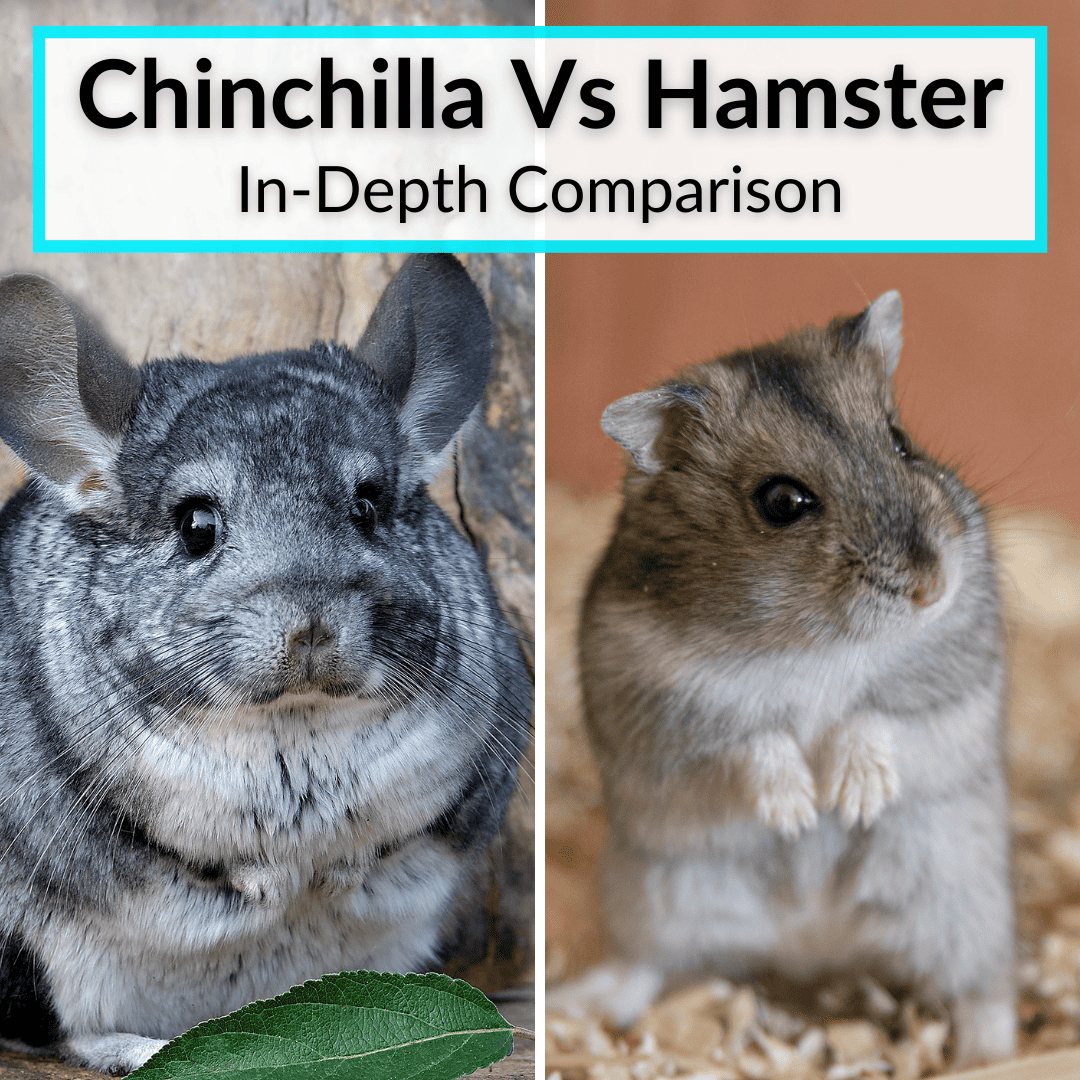
They are both adorable little rodents.
Apart from that, they have far more differences than similarities.
Comparing the chinchilla vs hamster directly makes one thing clear.
These are two very different pets.
That means one of the two will likely be far better for you than the other.
Which depends on your needs and preferences.
Keep reading for detailed comparison of chinchillas vs hamsters that will help you figure out which one is the better pet for you.
Contents
- 1 Chinchilla Vs Hamster
- 2 Hamster Vs Chinchilla: Final Thoughts
Chinchilla Vs Hamster
We will begin our comparison of the hamster vs chinchilla by looking at each rodent individually, before comparing them directly. We’ll discuss the advantages of each and finish with the reasons to get one over the other.
If you’ve read any of our other comparisons, like our article comparing the sugar glider vs chinchilla, you are already familiar with the format.
The Chinchilla

Chinchillas are tiny, furry rodents that look similar to rabbits but have ears like those of a mouse. The chinchilla originates from the South American Andes Mountain range, and their name is derived from the Chincha tribe.
Chinchillas have become popular pets in the United States and Europe, because of their thick and soft fur. In fact, they have the thickest, softest fur of all land animals.
In the wild, chinchillas live in large groups or herds. Each herd can have hundreds of chinchillas. That is why these pets need plenty of social interaction.
Chinchillas are about 10 to 12 inches in length. Wild chinchillas live for 10 to 12 years, while captive ones could live up to 20 years. They are crepuscular creatures, meaning they are most active during early dawn and after dusk. Their nighttime scurrying could disturb some people.
The Hamster

Hamsters are also rodents that make great pets. They are related to other rodents like mice, gerbils, etc. A scientist named Israel Aharoni began breeding Syrian hamsters in his laboratory in Israel. That is how hamsters reached the United States in the late 1930s.
Hamsters have gentle personalities and cute habits. There are many different sub-species or varieties of hamsters. The Syrian and Dwarf varieties are the most popular pets.
Hamsters are also nocturnal. In their natural habitats, they spend a lot of time burrowing and building tunnels. They do not live too long. Most hamsters have a lifespan of 2 to 3 years.
Differences Between Chinchillas And Hamsters
There are many differences between chinchillas and hamsters and the majority of them are obvious at first glance.
Subspecies
Hamsters belong to the class Rodentia and the subfamily Cricetinae. Chinchillas belong to the class Rodentia and the subfamily Chinchillidae.
Size
The main physical difference between a chinchilla and a hamster is their size. Chinchillas are almost twice the size of hamsters.
The average length of a chinchilla is about 12 inches, whereas that of a hamster is 5 inches. Chinchillas weigh about 1 to 2 pounds, while hamsters generally weigh between 0.5 and 10 ounces.
Lifespan
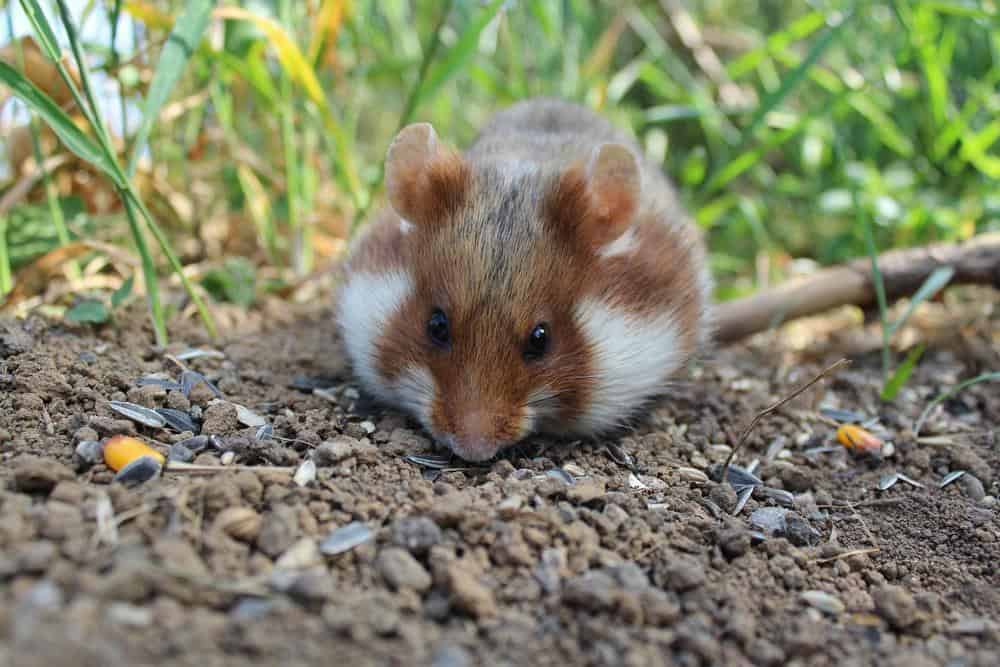
Chinchillas live a lot longer than hamsters. The average lifespan of captive chinchillas is 12 years, while that of a hamster is 2.5 years. And many chinchillas can live up to 20 years.
Fur Color, Texture, And Density
As mentioned above, chinchillas have soft, thick fur–the thickest fur among land animals. A hamster’s fur isn’t as thick.
Chinchillas are available in several different colors, ranging from grey, chocolate, black, white, beige, pastel, ebony, to violet.
Syrian hamsters are available in colors like beige, tan, sable, mink, blonde, cream, golden, etc. Chinchilla fur is softer than hamster fur.
Habits And Behaviors (Cheek Food Storage And Fur Slip)
Chinchillas do not hoard food in their cheeks, since they do not have cheek pouches. Hamsters, on the other hand, have the cute habit of storing food in their cheek pouches.
Chinchillas use a defense mechanism called fur slip, where they release a handful of their fur to startle their predators. Hamsters are not capable of this defense mechanism.
Sociability And Personality
Hamsters are generally solitary creatures. They don’t mind being housed alone. While they are friendly with humans, they do not particularly crave human interactions. Syrian hamsters are even known to get aggressive towards cage mates and are best housed alone.
Chinchillas are social animals. In the wild, they live in large herds and rely on their herd-mates for protection and company. That is why it is important to provide a companion for your chinchilla.
If that is not possible, you need to provide it with daily interaction with you to ensure that it thrives. How much attention do chinchillas need? You should aim to spend at least an hour a day playing with your pet outside the cage.
Grooming Needs
Hamsters, especially the long-haired varieties, need regular grooming, including trimming, hair brushing, and sand baths. Short-haired hamsters will also benefit from occasional brushing and sand baths.
Chinchillas have moderate grooming needs. All you need to do is provide your pet with regular dust baths to keep its fur free from parasites, oil, dirt, etc.
Diet
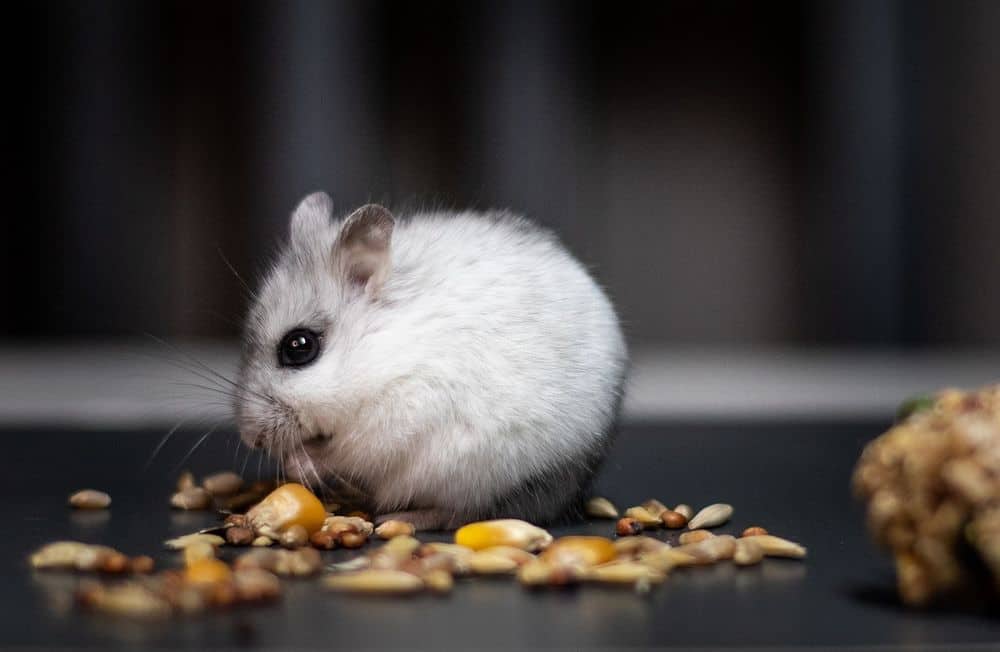
Chinchillas are mostly herbivores. They need a diet of hay and pellets (made especially for chinchillas). You can also feed them the occasional healthy treat.
Hamsters are omnivores. They need hay, fruits and veggies, commercial hamster pellets, occasional mealworms, boiled eggs, etc. You can not feed hamster food to chinchillas and vice versa.
Similarities Between A Chinchilla And A Hamster
Hamsters and chinchillas are similar animals in many ways, though their differences are more important in determining which is the better pet for you.
Exercise Needs
Both pets need plenty of exercise. You must aim to exercise your pets for at least 2 hours a day.
This includes providing a running wheel, adding several toys, tunnels, perches, hammocks, or chewing blocks inside their enclosures, and also giving them plenty of out-of-cage time.
Both animals are prone to weight gain if they do not get adequate physical activity. Moreover, both can also get depressed due to a lack of exercise.
Temperament
Both species of rodents are highly trainable, family-friendly, and also friendly with other pets. But you can’t house them together with other pets. Both are extremely intelligent creatures and can be trained (provided you are patient and consistent).
Both animals don’t like being handled too much. They’d rather run and play around you. However, you can get both of these pets used to being held and cuddled from an early age.
Certain Behaviors

Both animals are nocturnal (chinchillas are technically crepuscular) and get active after dark. Chinchillas and hamsters both love to dig and build tunnels and burrows. They need soft bedding material to dig into, as well as caves and tunnels made of cardboard rolls or tubes and pipes in their enclosures.
Great Pets For Beginners And Kids
Both animals make entertaining, cute, and cuddly pets. They have adorable personalities and habits that are educational and fun. They don’t require too much maintenance, like walking, cleaning after, or elaborate baths, like dogs and cats do. Both animals are trainable and can be taught tricks.
Chinchilla Vs Hamster At A Glance
| Chinchilla | Hamster | |
|---|---|---|
| Class/Family | Rodentia/Chinchillidae | Rodentia/Cricetinae |
| Size | Average length: 12" Average weight: 2 lbs | Average length: 5" Average weight: 6 oz |
| Lifespan (average) | 12 years | 2.5 years |
| Exercise Needs | 1-2 hours daily | 1-2 hours daily |
| Grooming Needs | Moderate | High (for long-haired varieties) |
| Personality & Temperament | Other pet-friendly, family-friendly, affectionate, intelligent, and trainable. Don’t like too much handling. Need companion chinchillas | Family-friendly, intelligent, and trainable. Don’t like too much handling. Do not need companions/prefer being solitary. |
| Habits | They do not store food in their cheeks. They love to dig and burrow, and they are crepuscular. Chinchillas use fur slip as a defense mechanism. | They store food in cheek pouches. They love to dig and burrow, and they are nocturnal. Hamsters are incapable of fur slip. |
| Diet | Mostly herbivorous | Omnivorous |
Advantages Of Chinchillas
Chinchillas make great pets, and they are fairly inexpensive. They also have softer fur than hamsters.
The main advantage of owning a chinchilla over a hamster is its long lifespan. Chinchillas live almost 5 to 10 times longer than hamsters.
Another advantage of owning a chinchilla is that they don’t need fur trimming or too much grooming. All you need to do is provide your buddy with regular dust baths to keep its fur clean, soft, and dry.
Chinchillas are generally gentler and more affectionate than hamsters. Hamsters are known to bite humans if they are woken abruptly from their sleep.
Advantages Of Hamsters
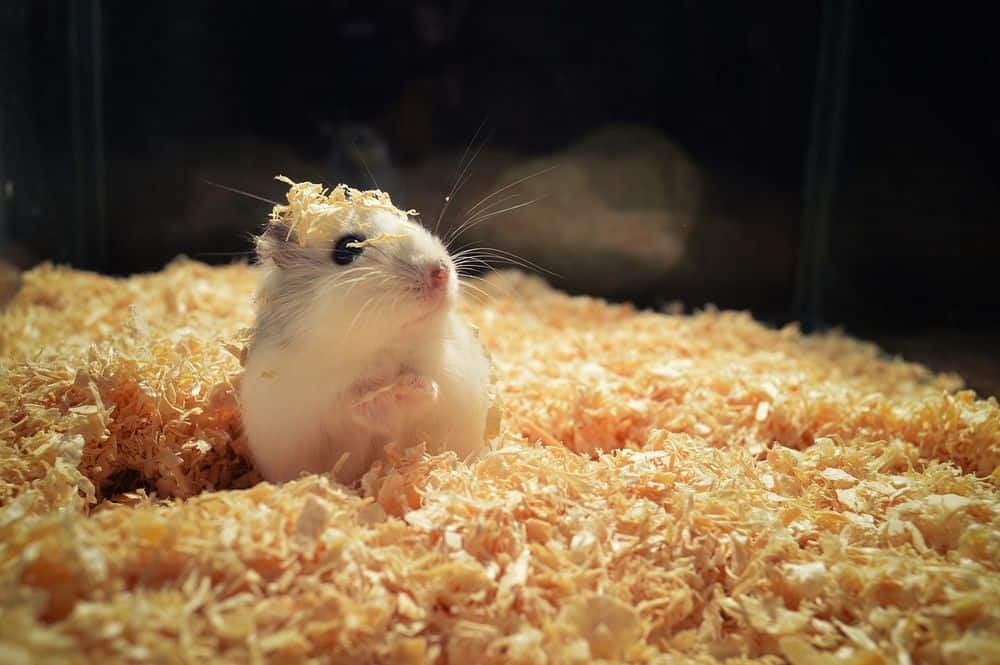
Hamsters don’t require extensive training. They are fairly inexpensive to own as pets. Hamsters are cute, and their habits and behaviors (like storing food in their cheek pouches) are highly entertaining.
Hamsters are easy to clean up after and don’t take up much space. They do not need elaborate baths. They also get the exercise they need on a running wheel.
Since they are mostly solitary animals, you won’t have to get a companion for your pet hamster.
Reasons To Get A Chinchilla
- Chinchillas are fairly easy to take care of, making them perfect for busy people and young children.
- They have a long lifespan
- They have the softest fur among small pets
- Chinchillas are fastidious self-groomers
- They don’t need too much training
- They do well in groups or pairs
Reasons To Get A Hamster
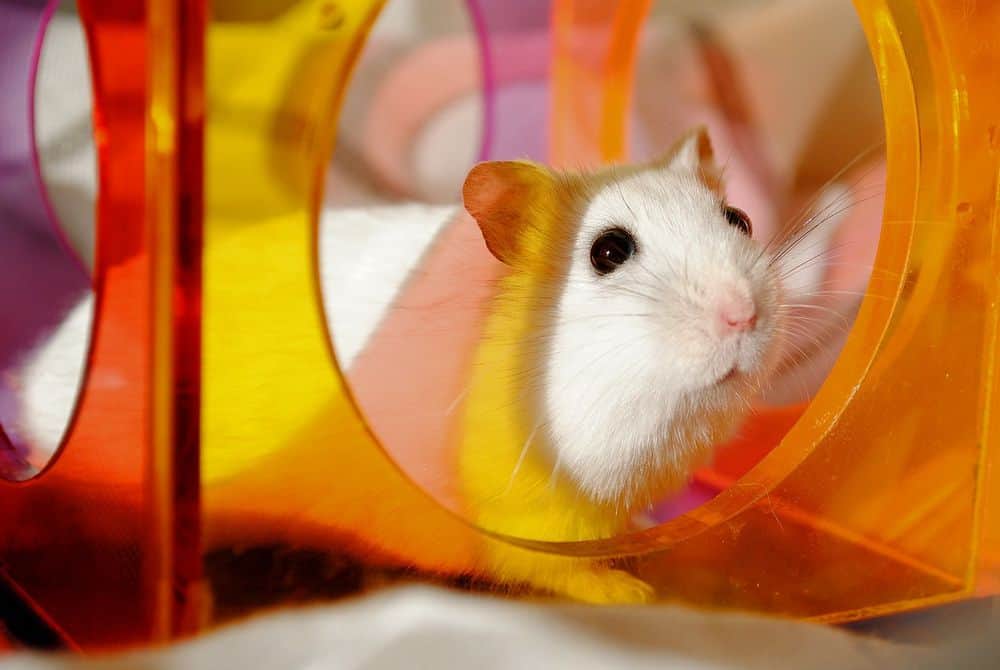
- Hamsters are inexpensive to own and don’t need much space, cleaning after, or maintenance
- They have cute behaviors and are highly entertaining
- They do not need extensive training
- Hamsters do not need much attention and make good pets for beginners and kids
- They do well on their own and don’t need a companion hamster
Hamster Vs Chinchilla: Final Thoughts
Hamsters and chinchillas both make excellent pets. They are both rodents and they do have a number of similarities. But when you compare the chinchilla vs hamster directly, it is the differences that stand out. They are also what will determine which is the better pet for you.
Obviously, the chinchilla is my choice. But that does not mean chinchillas are better pets for everyone. Many people will be better suited with a hamster, especially if you do not think you will be able to care for your pet for the next 15 to 20 years.
Of course, you could also get both pets. But you need to make sure you keep them separate. Due to the size and personality difference, chinchillas and hamsters do not get along peacefully. There are exceptions, but you can’t count on that.
Leave a Reply